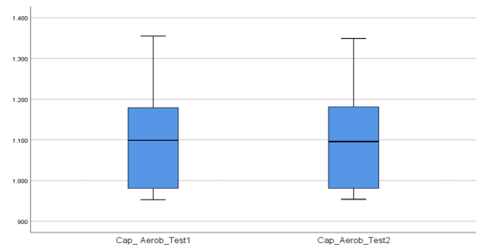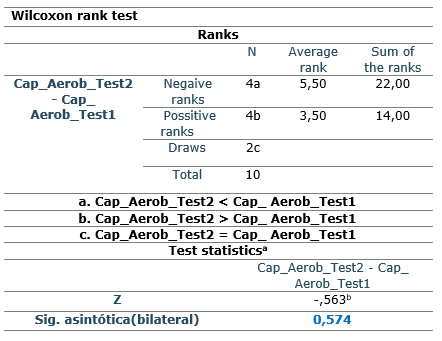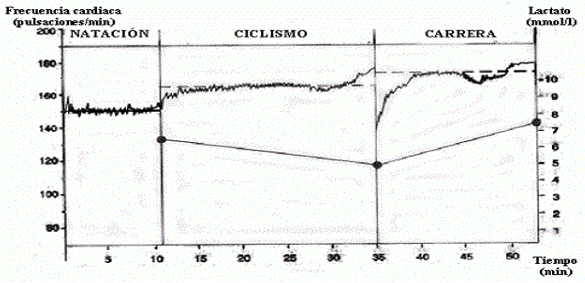Mi SciELO
Servicios Personalizados
Articulo
Indicadores
-
 Citado por SciELO
Citado por SciELO
Links relacionados
-
 Similares en
SciELO
Similares en
SciELO
Compartir
Podium. Revista de Ciencia y Tecnología en la Cultura Física
versión On-line ISSN 1996-2452
Rev Podium vol.16 no.3 Pinar del Río sept.-dic. 2021 Epub 09-Sep-2021
Original article
Test proposal to evaluate the aerobic capacity in youth triathletes
1Universidad Central "Marta Abreu" de las Villas. Las Villas, Cuba.
Today's sport motivates the search for new solutions that allow the athlete to respond to high physical demands within a sustainable sport. One solution is to search for tests for performance monitoring. The aim of this study is to propose a field test for the evaluation of aerobic capacity, carrying out a triathlon with lower values in terms of distance and duration with respect to the sprint triathlon. The study presents a field test proposal for the evaluation of aerobic capacity performing triathlons with shorter distances. The distance was determined through a practical study of competitive activity. In the validation, the test was applied to 12 athletes of the youth category with an average age of 16.3 years (± 1,3). The content validity was verified using the criteria of 12 specialists who stated that it adequately represents the aerobic capacity. Reliability and concordance were checked using the Wilcoxon rank test where asymptotic significance was 0.574. By the equivalence criterion, the test was monitored by comparing heart rate values with those of a simulated sprint triathlon. For the contrasted validity, the results of the triathletes were compared with those of five swimmers, three cyclists and two long-distance runners. The test times were lower in the triathletes, confirming that the test is specific for triathletes.
Key words: Triathlon; Sprint; Performance; Test; Aerobic capacity.
INTRODUCTION
The current sports scenario is becoming increasingly complex. This is due to different issues: more numerous, continuous and demanding competitions, greater participation of countries with a high competitive level, increase in the level of sports results and greater specialization of athletes from an early age.
Due to the continuous competitions, planning structures have had to be modified in order to maintain sporting form over a prolonged period of time and to have a successful competitive calendar. In addition, it is almost impossible to continue to increase the specificity of training, as well as the improvement of sporting performance by increasing training volumes.
Such a complex sporting panorama motivates new approaches from the methodological and pedagogical point of view. These new thresholds allow the coach and sport specialists in general to find and exploit the athlete's hidden potentials, which help him/her to respond to the current sporting demands. These arguments facilitate access to challenges without the help of doping substances, they also achieve a relationship between science and technology and counteract the athlete's sporting improvements only at the cost of increased intensity.
All of the aforementioned leads to the search for solutions that allow the development of a sustainable sport, even under the pressure of the sporting scenario described above. One of these solutions is "the search for tests with increasingly higher levels of information" (García et al., 2018). And that, in turn, allow a systematic monitoring of performance to assess the assimilation of loads by athletes.
The control of performance is carried out through different criteria, according to the characteristics of the sports. For sports of times and marks, the criterion to consider for the control of performance will be the athlete's personal best in the event in which he/she competes. In those disciplines where there is a clear influence of aerobic capacity, the best way to evaluate the performance of athletes is "to determine the endurance time in the test they usually practice" (López and Gorostiaga, 2018).
These periodic evaluations of performance, with the application of tests with the same characteristics as the competition, can have their drawbacks. Sometimes, they are events that due to their duration and distance become too demanding, causing wear and tear to the evaluated athletes, after the test is applied, which prevents their quick return to daily training. If the recovery process is not respected, then it could cause an accumulation of fatigue in athletes, which will be reflected in negative results in the main competition.
If to the already demanding training process, equally exhausting and difficult evaluations are added, the sport will be increasingly complex and unsustainable. One solution to this problem is the use of shorter tests because through them "it is possible to indirectly determine the endurance capacity in long duration tests" (López and Gorostiaga, 2018). This would contribute to the sustainability of sport, the protection of the athlete's health and would extend their sporting life.
Triathlon is an individual, combined and endurance sport; it is made up of three segments: swimming, cycling and running. It is done in the above order and the stopwatch does not stop until the end of the race. Therefore, being able to complete the race in the shortest time possible will be the main objective of the competitors.
Although it is a sport where three sports modalities are integrated, each one constituting a segment of the event, it would be incorrect to assume that a separate analysis of each segment would be sufficient to understand the inner workings of this discipline.
There are several distances that make up the triathlon; among them, the sprint distance is the one with which many normally start in the practice of this sport and is the distance called for the national youth championships in Cuba. The distances that make it up are 750 meters of swimming, 20 kilometers of cycling and five kilometers of running. The duration of a competition can be from 55 minutes to more than 1 hour and 30 minutes.
Due to the characteristics of the event, the aerobic capacity is considered as one of the determinant indicators of performance, according to Cejuela and Rodriguez (2007); this creates the need to maintain a control of the development of this capacity in the athlete by the coach, control that is done through the application of tests.
As indicators for the evaluation of aerobic capacity, the maximum oxygen consumption and the anaerobic threshold are used. Ogueta and García (2016) state that the maximum oxygen consumption is related to aerobic capacity and for Astrand, cited by Padilla et al., (1998), this is the most representative variable of aerobic capacity. It is defined as the value, from which there is no increase in oxygen consumption, even if the intensity is increased. The anaerobic threshold is defined, according to Wasserman (1967), quoted by Manso et al., (1996), as:
"the intensity of exercise or physical work above which the concentration of lactate in the blood begins to increase progressively, while ventilation also intensifies in a disproportionate manner with respect to the oxygen consumed" (p. 270).
Within the triathlon there are studies that have measured aerobic capacity, among which it can be mentioned those conducted by Basset and Boulay (2003) and Zapico and Calderon (2014), who used incremental tests in cycloergometer and treadmill. This trend is observed after performing a literature review. As a result, it can be seen that the tests used in triathlon are characterized by being parceled because they evaluate segments of the triathlete's race and not the race itself. They are taken from the sport disciplines that make up the triathlon. Few of them are used to evaluate aerobic capacity in Sprint distance triathlon. There is a predominance of laboratory tests and they do not study the athlete in conditions similar to those of competition.
The above mentioned, makes necessary the development of a test for aerobic capacity capable of reproducing, on a smaller scale, the conditions of sprint triathlon competition. And that in turn allows to maintain systematic evaluations of the triathletes without producing physical wear similar to those of the official distance.
The aim of this study is to propose a field test for the evaluation of aerobic capacity, carrying out a triathlon with lower values in terms of distance and duration with respect to the sprint triathlon.
MATERIALS AND METHODS
The methods used within the theoretical level were the inductive-deductive for the study of the tests in triathlon and for the practical study of the competitive activity. The analysis-synthesis during the process of elaboration of the test to carry out a study of the characteristics of the aerobic capacity and to achieve the design of the test. From the empirical level methods, the documentary analysis is used to obtain the necessary information on the subject in question, through the specialized literature. Measurement was used to measure the time in the designed test. Among the statistical-mathematical methods, Tukey's trimmed mean was used to calculate the mean during the study of the competitive activity and Wilcoxon's rank test was used to check the reliability of the proposed test.
As an applied research technique, the review of official documents such as the triathlon regulations and the Athlete Preparation Program was used to know the regulatory conditions, proposed tests and ways to design them. The survey was used to evaluate the content validity of the proposed test.
Participants
The specialists consulted to evaluate the content validity of the test were 12 triathlon coaches who had more than five years of experience in the sport preparation of the youth category. The test was applied in a practical way to 12 athletes, nine of them members of the youth teams of the province of Villa Clara and Cienfuegos with ages between 15 and 17 years and three of the triathlon team of Aguascalientes in Mexico, with 16 years of age. The average age was 16.3 years (± 1.3). All of them presented the informed consent, signed by the guardians. For the study of the contrasted validity, a group of athletes from the provincial Eide (Sport Initiation School) "Héctor Ruiz Pérez" was used. Five swimming, three cycling and two athletics athletes were selected, with an average age of 16.9 years (± 0.5), after previously presenting the informed consent.
Procedure
For the design of the test, first a study of the characteristics of the aerobic capacity was carried out to determine what duration the test should have and from here four possible durations of the test were defined. With these results and those obtained, corresponding to a study carried out in the competitive activity of sprint triathlon, the distance by segments of the test was determined, then the test was validated; for this, specialists were consulted to assess the validity of content, then the test was validated through the reliability and empirical validity of external criteria, the latter through the contrasted validity.
RESULTS AND DISCUSSION
In determining the distances by segments, it was used used the results presented by Fundora et al., (2019), obtained from a study of the competitive activity of sprint triathlon. Table 1 shows the percentage by segments with respect to the total distance. Table 2 shows the values of the average ratios, with their lower and upper limits and in Table 3, the average duration by segments and the average speed are represented (Table 1, Table 2 and Table 3).
Table 1. - Percentage by segments with respect to the total distance, obtained from the practical study of the competitive activity
| Segment | Swimming | Cycling | Foot race | Total Distance |
| Distance | 750 | 20 | 5 | 25,750 |
| % | 2,91 | 77,67 | 19,42 | 100 |
Table 2. - Values by ranges of the ratios corresponding to each segment, obtained from the practical study of the competitive activity
| Swimming | Cycling | Foot race | |
| Lower limit | 0,120 | 0,445 | 0,295 |
| Mean | 0,156 | 0,498 | 0,303 |
| Upper limit | 0,164 | 0,544 | 0,322 |
Table 3. - Average duration and average speed by segments, obtained from the practical study of the competitive activity
| Swimming | Cycling | Run | |
| Average duration (s) | 629 | 1 958 | 1 155 |
| Average speed (m/s) | 1,19 | 10,21 | 4, 32 |
According to the analysis carried out on the aerobic capacity, it was known that this begins to manifest itself energetically after ten minutes and, after 30 minutes, the steady state begins. Therefore, four possible total durations of the test were established, which were 10, 15, 20 and 25 minutes. From each of these possible total times of the test, the time per segment was calculated, to then obtain the distance of the segment.
For the calculation of the segment distance corresponding to each total test time, first proposed, the segment duration was calculated using the following formula (Equation 1).
Table 4 shows the values of the possible total test times chosen, the duration per segment and the distance corresponding to each segment. The following formula was used to calculate the distance per segment (Equation 2) and (Table 4).
Where:
Average speed of the segment is the one obtained from the practical study of the competitive activity.
Table 4. - Possible total times, duration per segment according to the reasons and the corresponding segment distance
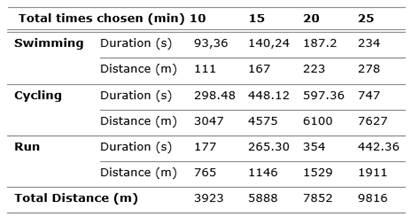
The values obtained from the distance by segments were adjusted, through the search for a better practical application at the time of tracing the route for each segment. The criterion to be considered to select the best proposal was that the percentage corresponding to each segment, with respect to the total distance, should be similar to the percentages obtained from the official Sprint Triathlon distance according to the results of the practical study of the competitive activity. The proposal that best approached these percentages was the one obtained from 20 minutes (Table 5).
Table 5. - Comparison between the percentages of the distance by segments, obtained from the 20 minutes proposal with the official distance
| Segments | Swimming | Cycling | Run | Total |
| Distance (m) | 200 | 6000 | 1500 | 7700 |
| % of the distance per segment of the proposal | 2.59 | 77.92 | 19.48 | 100 |
| % of the segment distance of the official distance | 2.91 | 77.67 | 19.42 | 100 |
Test validation results
The first aspect studied on the validity of the test was the content validity. In order to collect the opinion of these, a model called Aval of estimation was used. The results revealed that the 12 specialists affirmed that the test adequately represents the aerobic capacity.
Once the analysis of the behavior of the level of information of the test was concluded, it was proceeded to the analysis of the reliability and empirical validity. Reliability was tested for stability and concordance. Figure 1 shows the product of the comparison of the test results at two different times, results supported by table 6 through the application of the Wilcoxon rank test (Figure 1) and (Table 6).
Test monitoring results
This monitoring consisted in knowing if the proposed test provokes in the athlete similar effects to those provoked by the competition. In order to carry out this monitoring, it was resorted to the study of the behavior of the heart rate (HR) throughout the test. The values of heart rate in the sprint triathlon, which were used for comparison, were those presented by Berbalk et al., (1997), who was cited by Cejuela et al., (2007); these researchers were able to record through a simulated test of the sprint triathlon the behavior of the heart rate in the three segments, as well as the behavior of lactate (Figure 2) and (Figure 6).
Heart rate monitoring in the proposed test was carried out with the use of a Garmin heart rate monitor. This allowed recording the mean and maximum values in each segment, as shown in Figure 3, Figure 4 and Figure 5).
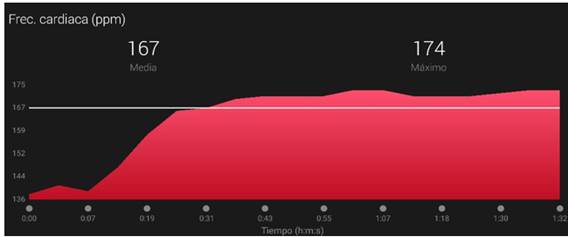
Fig. 3. - Behavior of the heart rate in the swimming segment during the proposed aerobic capacity test

Fig. 4. - Behavior of the heart rate in the cycling segment during the proposed aerobic capacity test
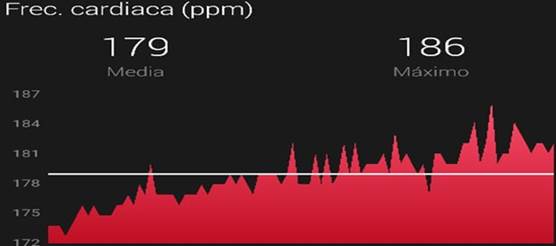
Fig. 5. - Behavior of the heart rate in the running segment during the proposed aerobic capacity test
Verification of the quality of the test on the basis of contrastracted validity. For the contrasted validity, the test times obtained from the triathletes were compared with the times of five swimmers, three cycling athletes and two track and field athletes from the endurance area. Figure 6 shows the comparison of these results. To make the comparison, the confidence intervals for each group were determined using the Student's t-value calculation.
 INF_INTER_C: Lower confidence interval. SUPERIOR_INTER_C: Upper confidence interval.
INF_INTER_C: Lower confidence interval. SUPERIOR_INTER_C: Upper confidence interval.Fig. 6. - Comparison of the confidence intervals resulting from the application of the aerobic capacity test applied to triathletes, swimmers, cyclists and runners
The proposed test is elaborated in the form of a Mini Triathlon to respect the competitive conditions, where each specialty is performed one after the other and in which, in the opinion of Zderic et al., (1997), quoted by Molina et al., (2009), the "transitions provide the triathlon with very special characteristics that determine performance beyond the simple sum of the determining factors of the sports that compose it" (p 46).
Three systems are known to be involved in energy transfer during physical activity:
Immediate energy production system: alactacid anaerobic system or phosphagen system.
Short-term system: anaerobic lactate system or glycogen and lactic acid system.
Long-term system: aerobic system or oxidative system González (2013).
The use of one system or another will depend on the type of physical activity to be performed. Of the three systems, only the long-term system allows an aerobic energy supply. And it is used "for activities lasting more than 120 seconds" López and Fernández (2006).
After 10 minutes, the energetic capacity of this system begins to be expressed. These qualities link it "to the physical quality of medium and long endurance" González (2013). Harre (1987), quoted by García et al., (1996) subdivides the long duration endurance (LER) in three, according to the duration of the effort. Considering the duration of the competition load of the Sprint triathlon (56'- 90'), its specific endurance would be the RLD- II, taking into account that it has a duration between 35'-90'.
During the development of a test it is important to ask yourself:
Do the tasks proposed in the test respond to the researcher's purposes?
How accurately does it address the study problem?
These questions indicate that, before applying the test, one must be sure that there is a correspondence between the contents and the researcher's intentions. Therefore, if this correspondence does not take place in the test, subjecting the athlete to an examination process by applying the tests may provide unreliable information.
In order to verify the quality of the proposed test, we start by using the criteria of specialists to determine if there is a correspondence between the content of the test and the researcher's intentions with it. The level of information or validity to be used, with the use of the criteria that specialists can provide, is known as content validity (Zatsiorsky, 1989).
The reliability of a test is the degree of coincidence of the results when its application is repeated to the same persons under equal conditions. For the analysis of reliability, two of its three indicators, stability and concordance, were applied.
The test stability indicator makes it possible to verify the possibility of reproducing the results obtained by repeating the test within a given time and under equal conditions. In the work, stability is measured in its two meanings; in one, the repetition of the test is carried out to obtain reliable data about the state of the researched during the time interval between the test and its repetition, while in the second, the importance of the conservation of the level of the researched within the group being analyzed is considered. The time selected between each measurement was one week.
In the first case, the test was compared at two different times on the same persons and the non-existence was determined from the statistical point of view of differences between the measurements made, that is, it speaks of the ability of the tests, from their results to infer about the current state of the capacities in the subjects, while the correlation index used in the second case indicates the distinctive possibility of the test, the higher the value of the coefficient obtained, the greater the possibility of informing and differentiating the subjects within the group in which they are inserted in the research.
In order to check if there were significant differences between the two moments in which the tests were applied, the Wilcoxon rank test was used. This test was used because the group of data was small and with integer values. The significance value in both tests was higher than 0.05, which indicates that there are no significant differences between the results obtained in the two moments submitted to comparison.
In the graph presented in figure 1, corresponding to the aerobic capacity test, note that between the mean of the two moments there are no significant differences, a conclusion that is supported by the results of the asymptotic value, presented in table 6 with the results of the Wilcoxon ranks test where the value is greater than 0.05.
In these results, undoubtedly influenced, the conception of the test and the selection of the components that integrate it (vital scenario of incidence), the mastery of the group of researched and the adequate selection of the time interval to consummate the test and its repetition, which allows to control during the application of the test the variable incidence of the training process in the final result of the test (especially in the sense of an improvement of the conditions and factors acting in the energetic system under study, caused by progressive movements of adaptation as a response of the organism to "the aggression" that represent the training loads along the programming structure).
The Wilcoxon rank test also allows to strengthen the criterion of test reliability based on concordance. The results obtained allow to infer that, regardless of the person who performs the test, as long as the standardization requirements described in the structure of the test are clearly met, the results obtained will be similar. This thesis is reached through the correlation of the results obtained in the tests applied by different researchers on the same subject.
Another criterion to determine the reliability of a test is the equivalence criterion. To determine whether this criterion is met, the results of the proposed test are compared with the results of a test that already exists and has been validated. If there are no significant differences between the results of the two tests, then the proposed test can be considered equivalent.
In the research, it was not possible to submit the proposed test to the equivalence criterion because there are no validated tests that allow evaluating the triathlete performing triathlon. For this reason, it was necessary to monitor the test. This monitoring consisted in knowing if the proposed test provokes in the athlete similar effects to those provoked by the competition.
The heart rate monitoring in the proposed test was carried out with the use of a Garmin heart rate monitor. This allowed recording the average and maximum values in each segment.
In the graph of the simulated triathlon, it is observed that the swimming segment shows average values around 150 beats per minute (bpm) and maximum values that reach up to 160 bpm. The values obtained in the swimming segment of the proposed test show average values of 168 bpm and maximum values of 174 bpm, somewhat higher than those obtained in the simulated triathlon.
The cycling segment in the simulated triathlon shows average values around 170 bpm reaching up to 180 bpm. This segment in the proposed aerobic capacity test showed an average of 173 bpm with a maximum of 178 bpm. The behavior expresses similar values between both studies.
Finally, in the running segment of the simulated triathlon, we observed heart rate values with a mean above 170 bpm and a maximum slightly above 180 bpm. The proposed test in the running segment exhibits mean values of 179 bpm and maximums of 186 bpm, suggesting coincidence with the simulated triathlon. These results indicate that the MiniTriathlon proposal, scenarios where the presented test materialized, provokes similar effects to those of the sprint triathlon from the point of view of heart rate behavior.
The other form of validation used was the contrasted validity. This consists of comparing the results of two groups that have come to differ in their daily activity, two groups that are known to be different in terms of certain characteristics. This type of empirical validity makes it possible to analyse whether the test offers the possibility of distinguishing subjects from different populations in terms of the level of development of abilities.
The cycling and running athletes were sampled so small because they were the only ones who, in addition to being able to swim, could complete the distance of the swim segment and continue with the cycling segment to complete the triathlon. In the graph, it can be seen that the upper values in the confidence interval constructed are lower in triathletes compared to other athletes and swimmers show lower values than cyclists and runners. This result could be due to the fact that the technical mastery of swimming is an important element to be able to perform a triathlon because it allows to complete the distance corresponding to this segment with efficiency and, therefore, energy will be available to undertake the two subsequent segments. This explains why swimming is the main source from which the triathlon is nourished, at least in our country.
The differences that appear reflected in the behavior of the confidence intervals between cyclists and runners could be explained by the fact that, in addition to swimming, the runners need to face cycling, an activity to which they are not accustomed because, although they can ride a bicycle, the aerodynamic position adopted on the bicycles of this sporting specialty demands technical requirements that are typical of the work of cyclists. The fact that the runners are not used to adopting this position during the cycling segment is an obstacle that affects their time performance.
This result suggests that the tests developed are specific to triathletes.
CONCLUSIONS
The distances to be covered by segments in each of the tests were determined, which made it possible to devise control procedures based on the time at which the indicators began to manifest themselves.
The tests constructed were submitted to a validation process based on scientific methodological criteria established in the specialized literature. The reliability of the tests, proven from the stability and concordance, concluded that they were reliable. The monitoring of the constructed tests was another element that allowed reaffirming the validity of the test by demonstrating that the results obtained in the heart rate in the elaborated Mini Triathlons were similar to those achieved during the execution of a conventional triathlon.
Note: The ratio is a binary relationship between quantities, where two quantities are compared by their quotient and it can be observed how many times one contains the other, as long as the compared quantities have the same unit of measurement. Calculating the ratio between the total time in the sprint triathlon and the time taken in each segment makes it easier to know how many times the total time of the sprint triathlon contains each of the segments.
REFERENCIAS BIBLIOGRÁFICAS
Basset, F. A., & Boulay, M. R. (2003). Treadmill and Cycle Ergometer Tests are Interchangeable to Monitor Triathletes Annual Training. Journal of Sports Science & Medicine, 2(3), 110-116. https://pubmed.ncbi.nlm.nih.gov/24627663/ [ Links ]
Cejuela, R., Pérez-Turpin, J., Villa, J., Cortell-Tormo, J., & Rodríguez-Marroyo, J. (2007). Análisis de los factores de rendimiento en triatlón distancia sprint. Journal of Human Sport and Exercise, 2(2). https://doi.org/10.4100/jhse.2007.22.01 [ Links ]
Fundora García, P., García Vázquez, L. A., y Rabassa López Callejas, M. A. (2019). Competitive activity in the sprint distance triathlon. Contemporary trends and their regularities. Conrado, 15(68), 285-290. http://scielo.sld.cu/scielo.php?script=sci_abstract&pid=S1990-86442019000300285&lng=es&nrm=iso&tlng=en [ Links ]
García, L. A., González, J. A., y Rabassa, M. A. (2018). Los escenarios deportivos contemporáneos. Presentado en Conferencia magistral. Convención científica internacional, Las Villas, Cuba. [ Links ]
González, M. E. (2013). Fisiología del ejercicio: Respuestas y adaptaciones provocadas por el ejercicio físico y el entrenamiento. La Habana, Cuba. [ Links ]
López, J. A., y Gorostiaga, E. (2018). Evaluación del deportista de alto rendimiento deportivo (Tesis de Maestría). COES., Madrid, España. [ Links ]
López, J., y Fernández, A. (2006). Fisiología del ejercicio (2a Edición). Editorial Médica, Panamericana. [ Links ]
Manso, J. M. G., Caballero, J. A. R., y Navarro, M. (1996). Bases teóricas del entrenamiento deportivo: (Principios y aplicaciones). Gymnos. https://dialnet.unirioja.es/servlet/libro?codigo=96890 [ Links ]
Molina, V. D., Lozano, A. B. P., Sánchez, M. Á., Zapico, A. G., Peinado, P. J. B., y Montero, F. J. C. (2009). La respuesta cardiorrespiratoria durante la segunda transición del triatlón: Revisión. RICYDE. Revista Internacional de Ciencias del Deporte, 5(14), 45-58. https://www.redalyc.org/articulo.oa?id=71011547006 [ Links ]
Ogueta-Alday, A., y López, J. G. (2016). Factores que afectan al rendimiento en carreras de fondo. RICYDE. Revista Internacional de Ciencias del Deporte, 12(45), 278-308. https://dialnet.unirioja.es/servlet/articulo?codigo=5565551 [ Links ]
Padilla, J., Eguía Lis, M. C., Licea, J., y Taylor, A. W. (1998). Maximal aerobic capacity and sports activity in Mexicans from 13 to 56. Archivos Del Instituto De Cardiología De México, 68(3), 224-231. https://pubmed.ncbi.nlm.nih.gov/9810344/ [ Links ]
Zapico, A. G., Benito, P. J., Díaz, V., Ruiz, J. R., y Calderón, F. J. (2014). Perfil de la frecuencia cardíaca en triatletas altamente entrenados. Revista internacional de Medicina y Ciencias de la Actividad Física y el Deporte, 10(10). https://repositorio.uam.es/handle/10486/662997 [ Links ]
Zatsiorsky, V. M. (1989). Metrología deportiva: Libro de texto. Planeta. https://books.google.com.cu/books/about/Metrolog%C3%ADa_deportiva.html?id=P45WPQAACAAJ&redir_esc=y [ Links ]
Received: November 17, 2020; Accepted: June 06, 2021











 texto en
texto en 



